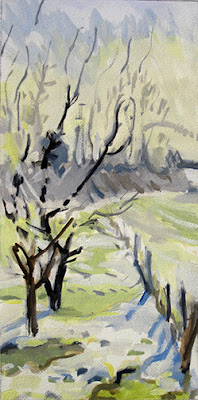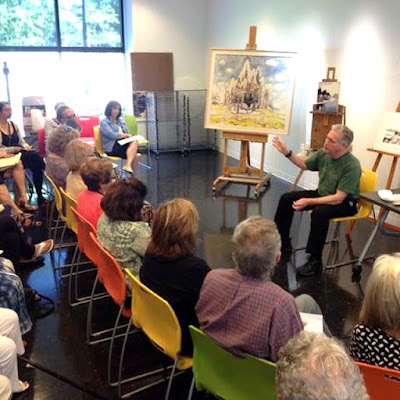Is Making Copies Too Old School?: Charles Burchfield
Philip Koch oil copy of the left 1/3 of Charles
Burchfield's Early Spring Sunlight from 1950.
I was documenting paintings in my studio this morning. Two pieces needed labeling that I made during my first two stays in Buffalo this year as the Artist in Residence at the Burchfield Penney Art Center (BPAC). They were copies of my favorite sections of two of Charles Burchfield's watercolors from BPAC's Permanent Collection.
My claim to fame is I am the only human ever to directly make copies of Burchfield watercolors in oils (I tell this tongue in cheek). It's a dreadfully old school thing to do. Burchfield Penney Art Center indulged my whim. They were trusting enough to set up first Burchfield's Early Spring Sunlight (1950) and then his Early Spring (1966-67) on an easel for several days each for me to examine them and copy from them.
Charles Burchfield's Early Spring Sunlight on BPAC's easel at left.
At right Koch's French easel with the beginning of his oil copy.
Art students not that long ago were expected as part of their training to copy the work of acknowledged masters as a core preparation to become artists in their own right. When the modernist revolution swept through the arts in the early 20th century daring innovation came to valued in painting. The worst fear was to be seen as just repeating someone else's formula.
Philip Koch copy of the central section of Charles Burchfield's
watercolor Early Spring from 1966-67
Visual art after all is a language, we learn it by absorbing the grammar that's been hammered out by the best of the artists who've gone down the road before us. Budding novelists pick up the tools to tell their own unique stories by reading the master writers of the past. Whether you want to discover what's expressive in shape and color or in artfully turned sentences you have to revel in the best of what's been done before.
In the make shift studio in BPAC's Classroom, Burchfield's Early
Spring on the easel with Koch speaking to BPAC's docents in July.
Is there a danger of letting the art of the past influence us too much? Sure. There are all sorts of contemporary paintngs of young women lounging on the beach in what look like ball gowns stolen from the costume department of the film Gone With the Wind. I think of Coubet's quote "I swam in the river of tradition. The others drowned in it." Excessively boastful of course, but he makes a point we need to hold in mind.
Art of the past is a lens for us to see our daily experience more clearly. Burchfield articulated his inner sensations to us on a very hight level. He'd be delighted if newer artists learn from his example and come closer to their own authentic voices.






